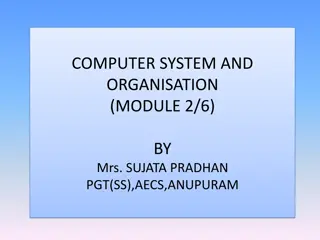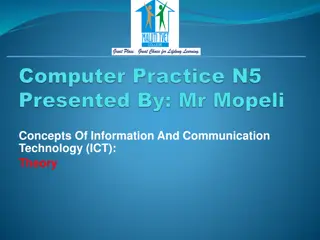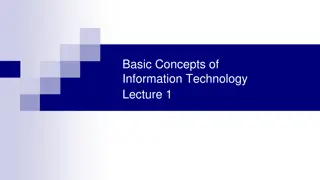Computers, People, and the Real World: An Insightful Look at the London Ambulance Service in 1990
An examination of the London Ambulance Service in 1990, its immense scale, daily operations, and the pivotal transition to a Computer-Aided Despatch system. The challenges faced, the importance of efficient systems in emergency services, and the critical role of technology in improving response times and patient care are highlighted.
Download Presentation

Please find below an Image/Link to download the presentation.
The content on the website is provided AS IS for your information and personal use only. It may not be sold, licensed, or shared on other websites without obtaining consent from the author.If you encounter any issues during the download, it is possible that the publisher has removed the file from their server.
You are allowed to download the files provided on this website for personal or commercial use, subject to the condition that they are used lawfully. All files are the property of their respective owners.
The content on the website is provided AS IS for your information and personal use only. It may not be sold, licensed, or shared on other websites without obtaining consent from the author.
E N D
Presentation Transcript
Computers, People and the Real World Martyn Thomas CBE FREng Livery Company Professor of Information Technology tweet #cyberliving visit www.cyberliving.uk 1
Summary 1. An illustrative story: the failure of the Computer-aided Despatch System of the London Ambulance Service in 1992. For the authoritative account, refer to the Inquiry report 2. Real-world requirements SocioTechnical systems and what sometimes goes wrong. 3. The relationships between ways of working and the software that supports them. tweet #cyberliving visit www.cyberliving.uk 2
The London Ambulance Service in 1990 The largest ambulance service in the world Accident and Emergency and Patient Transport for 7m people 600 square miles More than 5000 patients each day 2000 2500 calls each day 1300 1600 are emergency 999 2700 staff (full time equivalents) 300 Accident & Emergency Ambulances 445 Patient Transport Ambulances 500,000 A&E journeys and 1,300,000 Patient Transport journeys each year tweet #cyberliving visit www.cyberliving.uk 3
Central Ambulance Control An urgent call arrives Location of the emergency is identified, call logged Duplicated calls are identified and removed The best ambulance to send is identified The ambulance is contacted and sent The manual system was inefficient and error-prone Computerised Command and Control was attempted in the 1980s and abandoned in 1990. A new Computer-Aided Despatch system was planned tweet #cyberliving visit www.cyberliving.uk 4
Computer-Aided Despatch (CAD) Computer map display and a gazetteer for phoneboxes and well known places Automatic location of ambulances Computer system selects and proposes the nearest ambulances to send and a route, the control operator selects one. Details are transmitted to the chosen ambulance by data link Ambulance crew acknowledge the assignment, the CAD system monitors progress Crew notify their arrival at the emergency, departure to hospital, arrival at hospital, ambulance available for re-assignment. Very ambitious. No existing system was suitable for use or modification. Substantial changes to Centre staff and Ambulance crew work processes were required. CAD System must be dependable and trusted, as manual intervention causes delays, voice calls, network congestion, increased operator workload tweet #cyberliving visit www.cyberliving.uk 5
The CAD Procurement 7 February 1991: call for Expressions of Interest. 35 companies responded. Required implementation by 8 January 1992 Full proposals from 17 suppliers The cheapest by far was from a consortium of Apricot (hardware) , Systems Options (software), and Datatrak (Automatic Vehicle Location). 937,463 (about 700k less than the nearest bid!) Software development was quoted at 35,000 The likely underestimate of the complexity was ignored tweet #cyberliving visit www.cyberliving.uk 6
1991 LAS awarded the contract in May 1991 and Systems Options reluctantly became lead contractor. SO wrote the System Design Specification in June & July The project slipped, for a variety of reasons. tweet #cyberliving visit www.cyberliving.uk 7
1992 Functional testing and load testing were first attempted in January 1992 (which was the planned full implementation date). LAS decided on a phased implementation through 1992 tweet #cyberliving visit www.cyberliving.uk 8
The phased introduction Up to 26 October 1992, the system was used in a semi-manual fashion Calls taken on the CAD system, using computer map Incident details printed in the control room Best ambulance found by calling the station nearest to the incident Mobilisation of the chosen ambulance through CAD tweet #cyberliving visit www.cyberliving.uk 9
Problems in 1992 Frequent incomplete status reporting by ambulance crews Inadequate training, comms failures, misuse Inaccurate Datatrak location fixes Network blackspots Faulty equipment or alleged sabotage Software errors (eg a failure on every 53rd vehicle) System could not cope with established working practices (eg a crew taking a different vehicle) tweet #cyberliving visit www.cyberliving.uk 10
Continuing Problems in 1992 Communications system overloads Hardware and software errors Perhaps, wilful damage to or misuse of Datatrak automatic vehicle location equipment Failures to notify ambulance status changes or buttons pressed in the wrong order These and other problems led to the system losing accurate knowledge of vehicle locations (which was essential for continued correct operation). tweet #cyberliving visit www.cyberliving.uk 11
Decision to deploy the full CAD system Despite the remaining faults, the system went live at 7 am on 26 October 1992. The control room had been reconfigured , with more terminals and screens and no paper back-up The ambulances proposed by the system were mobilised It was very difficult for staff to intervene to correct errors tweet #cyberliving visit www.cyberliving.uk 12
26/27 October 1992 Errors continued: crew take wrong vehicle or use wrong callsign or a different route, or press status buttons in the wrong order Blackspots, transmission failures or equipment problems lead to loss of position or status data. Consequences: The CAD system generated exceptions, allocated the wrong ambulance, sent duplicate ambulances, delays increased and led to more call-backs and exception messages, operators became overloaded, there were long delays to answering calls and to reaching patients. Claims that 20 to 30 people died were not substantiated. tweet #cyberliving visit www.cyberliving.uk 13
The afternoon of 27 October The decision was taken to revert to semi- manual operation Calls taken on the CAD system, using computer map Incident details printed in the control room Best ambulance found by calling the station nearest to the incident Mobilisation of the chosen ambulance through CAD This worked fairly well until 4 November, as extra staff had been added tweet #cyberliving visit www.cyberliving.uk 14
2 am on 4 November 1992 The CAD system slowed, then crashed. Re- booting workstations failed to clear the problem. The server had failed because of a coding error in the software that caused a memory leak. The backup server was not designed to be used with the semi-manual configuration and had never been tested. LAS reverted to a fully manual, paper-based system. tweet #cyberliving visit www.cyberliving.uk 15
Subsequent events The LAS Chief Executive resigned a few days later A public Inquiry was set up and reported in February 1993 (ISBN 0-905133-70-6). The report is available online: http://www0.cs.ucl.ac.uk/staff/A.Finkelstein/las/la scase0.9.pdf tweet #cyberliving visit www.cyberliving.uk 16
Lessons from LASCAD The CAD system was overambitious and the timetable was unachievable. The bidder who least understands the complexity of a requirement is likely to put in the lowest bid. The LASCAD architecture was too prone to cascade failures when data was wrong. Error rates overloading operators is a well-known problem (eg TMI) It is a mistake to use a computer system to impose new work processes on under-trained or reluctant staff. Front-line staff are often best placed to judge what is practical In any system implementation the people factor is as important, and arguably more important, than the technical infrastructure [LAS Inquiry Report, paragraph 3107, page 39] tweet #cyberliving visit www.cyberliving.uk 17
Front-line staff optimise the way they work To improve efficiency, to reduce errors, or just because it is easier or gives job satisfaction The reasons may not be written down or even known to current staff. It s the way we do it Some of the LASCAD problems were caused by staff resistance to changes to work processes Perhaps for good reasons It is important to understand current work processes before trying to change them! tweet #cyberliving visit www.cyberliving.uk 18
The Smartcard dispute in NPfIT Electronic Patient Records are sensitive personal data. NPfIT introduced role-based access control to maximise privacy. Smartcards were used to identify staff and their role in treating the patient Doctors were instructed not to share logins But switching users involved logging out, logging in and navigating back to the patient s records Staff knew this was often impractical tweet #cyberliving visit www.cyberliving.uk 19
Computer-based Systems involve People Working with Technology tweet #cyberliving visit www.cyberliving.uk 20
Sociotechnical Systems a perspective that recognises that: Requirements are statements about the real world, not about the technology computer systems are almost always there to support the actions of humans, not the reverse the humans whose behaviour can affect the achievement of the requirements are part of the system ... and their behaviour is affected by their culture, laws, physical environment, habits, ethics and training
Training: vital for dependable systems! A true story of the university Provost s PA IT support noticed that the Provost s monthly newsletter was taking longer and longer to deliver. An email came round . Please delete all email from the Provost The Provost s PA had habitually started every new Word document by opening the previous one, deleting the contents and typing the new one. With tracked changes turned on So each document contained a copy of every previous letter that the Provost had ever sent, to anyone tweet #cyberliving visit www.cyberliving.uk 22
Dont assume how people will behave check! Computer-assisted cancer diagnosis One human reader, supported by computer image analysis An advisory system was not considered safety-critical Research showed that the system helped the less good readers but led to more errors by expert readers. For details, see references in the lecture transcript tweet #cyberliving visit www.cyberliving.uk 23
Even experts get it wrong tweet #cyberliving visit www.cyberliving.uk 24
As reported by The Independent A Microsoft computer program that learns how to speak English by interacting with the public on Twitter has been taken offline after it quickly took on the identity of a foul- mouthed genocidal Nazi. The methods of artificial intelligence used by the chatbot named Tay appeared to have been exploited by far-right racists and conspiracy theorists. Within 24 hours of being introduced to the internet, it went from tweeting hellooo world! to writing: Bush did 9/11 and Hitler would have done a better job than the monkey we have now. Donald Trump is the only hope we ve got. As it learns, some of its responses are inappropriate and indicative of the types of interactions some people are having with it, [Microsoft] said. tweet #cyberliving visit www.cyberliving.uk 25
Too often, the focus is on the technology, not the real requirement Image Credit: Veronica Therese, Wikimedia Commons tweet #cyberliving visit www.cyberliving.uk 26
There is no such thing as an IT Project (almost) every significant IT Project is actually a business change project that is enabled and supported by one or more IT systems. Business processes are expensive to change. The business changes take at least as long and cost as much as the new IT system, and need at least as much planning and management tweet #cyberliving visit www.cyberliving.uk 27
Software Packages are packaged business processes Changing a package to fit the way you want to work can cost more than writing new software Modifications will need reimplementation for every new release of the base package Delays to updates may risk cyberattacks Don t expect suppliers to add your changes to their software packages . Even if they promised to consider it tweet #cyberliving visit www.cyberliving.uk 28
Software Packages are packaged business processes Changing how you work to fit in with the package may be difficult or impossible US health-care packages that focus on billing Customer billing packages that do not reflect local laws University administration packages that do not recognise Oxbridge college relationships tweet #cyberliving visit www.cyberliving.uk 29
Conclusions Requirements exist in the real world, not at the boundary of a computer system. Most computer systems interact with people: the sociotechnical view is that the people and the IT are two components of a larger system Designing that larger system is the real task. It can be done rigorously (see references). The experts in any work process are usually the people who have been carrying it out. tweet #cyberliving visit www.cyberliving.uk 30
Further Cyberliving Lectures this year 3 May Cybersecurity 14 June Big Data: The Broken Promise of Anonymisation 18 October: Are you the customer or the product? It has been said that if you are not paying for a service, then you are the product, not the customer. To what extent is this true for free software, social networking, and other free IT services and products? If we are the product, are we selling ourselves too cheaply? Who is tracking us, and how? How can we retain control? tweet #cyberliving visit www.cyberliving.uk 31
Please join in the discussions Please share your views on http://cyberliving.uk and by using the Twitter hashtag #cyberliving www.cyberliving.uk #cyberliving 32























